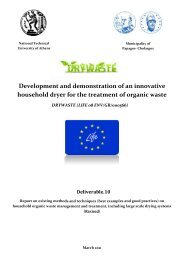MOROCOMP (LIFE TCY05/MA000141) - Unit of Environmental ...
MOROCOMP (LIFE TCY05/MA000141) - Unit of Environmental ...
MOROCOMP (LIFE TCY05/MA000141) - Unit of Environmental ...
Create successful ePaper yourself
Turn your PDF publications into a flip-book with our unique Google optimized e-Paper software.
educed and on the 18 th day ammonium concentration was 613.79mg/L. Nitrates in<br />
leachates presented a significant increase throughout the duration <strong>of</strong> the 2 nd trial. On<br />
the 3 rd day their concentration was limited at 31.73mg/L while on the 18 th day it has<br />
been increased approximately 14 times reaching at 442.51mg/L. Table 20 shows also<br />
that heavy metals such as Cd, Cr, Cu, Ni, Pb and Zn were present in leachates<br />
throughout the process. The metal concentrations were much below the indicative<br />
values for wastewater disposal as shown in Table 7.<br />
According to BOD 5 , ammonium and nitrates values obtained for the leachates <strong>of</strong> the<br />
2 nd composting trial it can be concluded that leachates had a heavily polluted organic<br />
and inorganic load which needs to be treated before its final disposal. The quantity <strong>of</strong><br />
leachates production during the 2 nd trial was limited and stored to an impermeable<br />
reservoir for sufficient period <strong>of</strong> time to be stabilized at lower values through aeration.<br />
Although composting can be assessed for sludge treatment and reuse through land<br />
application, leachates remain an environmental problem since the treatment <strong>of</strong> solid<br />
waste through composting results in transferring the problem from solid to liquid<br />
phase. Leachates must be treated accordingly in order to be disposed to a water<br />
recipient based on the suggested standards shown in Table 7. However Directive<br />
91/271/EEC seeks to harmonise measures relating to the treatment <strong>of</strong> wastewater at<br />
Community level in order to protect the environment from any adverse effects due to<br />
discharge <strong>of</strong> such waters.<br />
5.2.8. Removal and collection <strong>of</strong> the composting end product<br />
The removal and collection <strong>of</strong> compost was perfomed on the 23 rd day <strong>of</strong> the<br />
composting process through the removal portals that are situated at the bottom part <strong>of</strong><br />
the bioreactor. To facilitate the discharge <strong>of</strong> the end product the agitation system was<br />
operated for small intervals. The compost was collected manually using shovels and it<br />
was spreaded in an open area outside the building where the bioreactor is installed<br />
where it remained for five days to further reduce its moisture content (during that time<br />
the end product was regularly agitated manually). Finally the compost was stored in<br />
order to be used to the open field experiments.<br />
75










